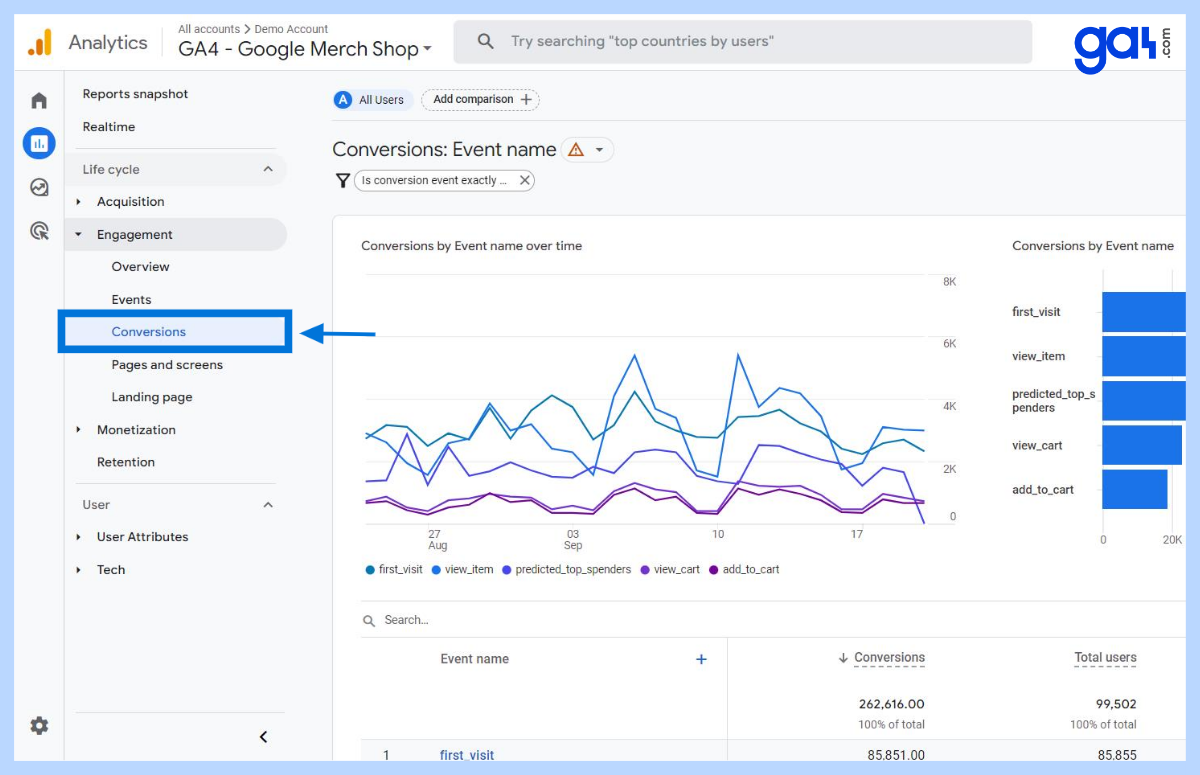You are familiar with the power of GA4 when it comes to tracking and optimizing your online presence.
As a Shopify store owner, you also know that integrating GA4 with your Shopify store can help you take your data tracking and analytics to the next level.

However, there’s another GA4 feature that you should fully utilize so you don’t miss out on any opportunities to increase your sales: Conversion tracking.
To unlock the full potential of conversion tracking in GA4, first, you should make sure to:
- have accurate data flow in GA4
- set up GA4 ecommerce tracking properly.
GA4 sets the "purchase" event as a conversion by default, so you don't need to take any specific actions if you only want to track the "purchase" event as a conversion.
However, for this to work, ensuring you have a properly functioning Shopify GA4 integration is essential.
Now, let’s explore everything you need to know to fully utilize Shopify and GA4 conversion tracking to help you get the most out of your data analytics.
What is Conversion Tracking in GA4?
Conversion tracking is a key feature of Google Analytics that allows you to measure how successful your website or app is at converting visitors into customers or achieving other goals.
In other words, conversion tracking helps you understand how effectively your website is driving user actions that are important to your business, such as sales, form submissions, sign-ups, etc.
With Google Analytics 4, conversion tracking has been redesigned to be more flexible and customizable, allowing you to track a wide range of conversions that are relevant to your e-commerce business.
This includes both traditional e-commerce conversions, such as ‘purchase’ which is marked as conversion automatically once you make sure your e-commerce tracking works well, and other types of conversions.
To set up conversion tracking in GA4 , you'll need to create conversion events that track specific user actions on your website, such as a button click or a form submission.
You can then use these conversion events to track and analyze user behavior, such as how often users are completing a specific action, which channels are driving the most conversions, and which segments of users are most likely to convert.
Overall, conversion tracking is an essential tool for understanding and optimizing the performance of your website, and with GA4, it's easier than ever to set up and customize your conversion tracking to meet your specific business needs.
Check out our relevant guide if you don't have GA4 up and running on your store: Setup GA4 on Shopify
Why GA4 Conversion Tracking Matters for Your Shopify Store?
GA4 sets the "purchase" event as a conversion by default so if you only want to track the "purchase" event as a conversion you don't have to take any specific actions. For this to work, you need to make sure you have a properly working Shopify GA4 integration.
By setting up GA4 and conversion tracking properly, you can gain valuable insights into how your customers are interacting with your website and where you might be able to improve the user experience to drive more conversions.
For example, you might discover that customers are abandoning their shopping carts at a particular stage in the checkout process, indicating that you need to make some changes to that stage to make it easier or more appealing for customers to complete their purchases.
To be more specific, with conversion tracking in GA4, you can:
- track a wide range of conversion events such as product purchases and other valuable user actions like sign-ups or form submissions
- gain valuable insights into how your customers are interacting with your website and where you might be able to improve the user experience to drive more conversions
- monitor which channels or campaigns are driving the most conversions so you can focus your marketing efforts on the strategies that are most effective at driving sales
- improve user experience to ultimately drive more sales and revenue.
- identify the best products and categories to promote
- test different pricing strategies and discounts
- improve your checkout process and reduce cart abandonment
Long story short, GA4 conversion tracking is an essential tool for any Shopify store owner looking to improve their online presence and grow their business.
How to Set Up Shopify and GA4 Conversion Tracking?
As mentioned above, you get the purchase event marked as conversion, provided you have a Shopify - GA4 e-commerce tracking that works.
However, as an e-commerce business owner, you may want to see how your business is performing in terms of conversions through different parameters and events.
If that’s the case, you can follow the instructions provided in the video below and learn how to mark events as conversions in Google Analytics 4:
You may also want to create custom events for a couple of important reasons such as:
- to track specific user interactions as custom events allow you to see specific user interactions on your website that may not be captured by default GA4 events. For example, you can create a custom event to track clicks on a particular button or form submission.
- to secure more accurate conversion tracking as you can gain more accurate insights into how users are interacting with your website or app and what actions are driving conversions by monitoring specific user actions
- to optimize your marketing efforts as you can have great data about which marketing channels and campaigns are driving the most valuable user interactions and conversions.
Google Analytics 4 makes it all super-easy. If you want to create custom events, you can follow the steps in the video below.

